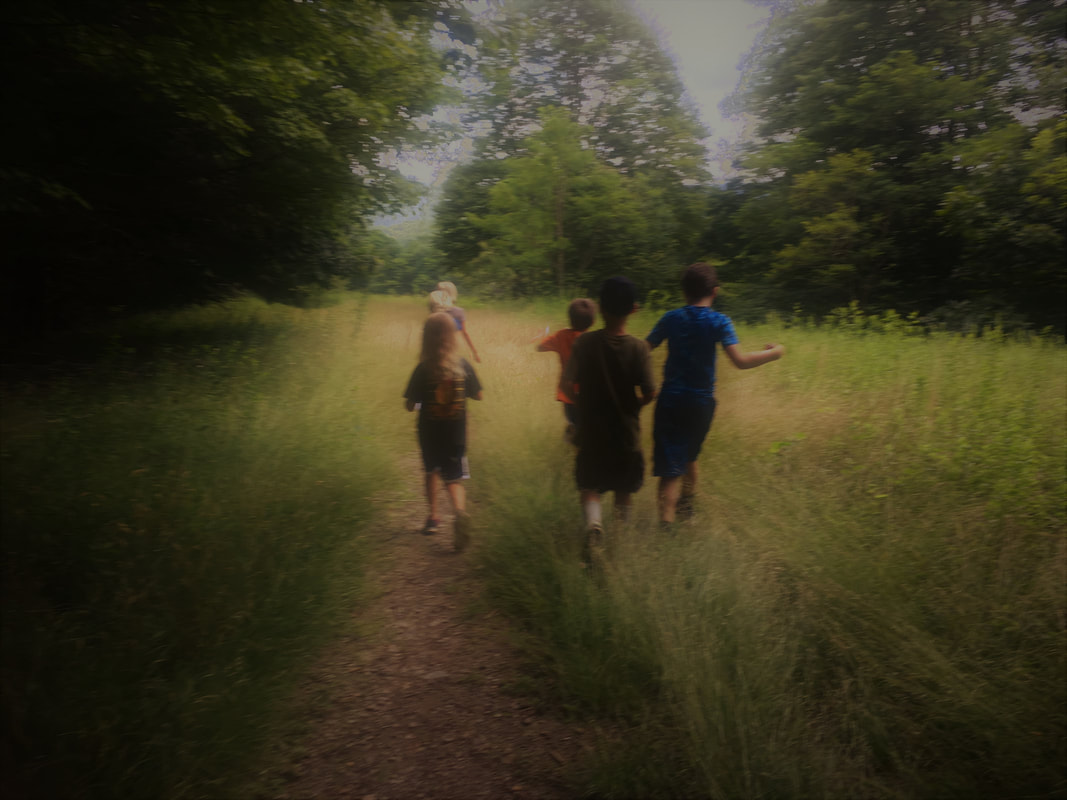|
It’s the perfect cover. I am rendered innocuous by the small device in my hand. Sitting against a tree, I stare at my smart phone. Most of the kids are probably used to grown-ups zoning out like this so they don’t realize that I am chaperoning/spying on them. Because of my device, they quickly forget that I am there and I get a rare insight on the native behavior of a group of about a dozen 5-10 year-olds when they are left to their own devices.
The children gathered here for our Wild Wednesday were waiting in line to use the mini zip-line. It is a pretty safe contraption, but not without some risks. Someone could get clobbered if they were in the way of a dangling child zipping down the hill. The kids have to wait to take turns—a lesson some have learned better than others. There are plenty of opportunities for an adult like me to step in and offer an opinion, suggest a better way, insist on kinder language, but I let these moments go by without comment. Perhaps I should share this method with sociologists as a safe way to test the dark premises of The Lord of the Flies? Take a group of kids to the woods, station adults holding smartphones or laptops at regular intervals, and secretly watch it all unfold. (This strategy would break down if the kids get hungry. To prevent peckish children from popping adults’ bubble of inconsequence, we would have to place an abundance of snacks throughout the study area.) “I am going to kill you!” one girl says to her brother. “If you did that you’d be a murderer!” says a friend. “You would go to jail forever,” another adds helpfully. “Nobody is going to kill anyone here,” says a self-possessed 10 year-old. “Clear!” she yells to the hill. She had set herself up as a runway guard and gives the signal to the boy gripping the handlebars and waiting on top. He launches himself off the top and kicks his feet as he zooms down the cable toward the bottom. There, he is stopped with a giant hug by another self-appointed guardian of safety, the brother who had just received the death threat. This wild kid society is both ruthless and supportive at once. Some children get impatient while waiting in line and went over to work on one of the stick forts they had started last week. Another who has had too much of the fray wanders down the path a little to the frog pond seeking quiet and a chance encounter with an amphibian or maybe a fairy. Our woods playground has proven to be the right size for kids to feel free and parents to let go of the reins a little. That’s the trick—knowing how much to hold on to the reins when children are testing physical and social boundaries. If someone ends up in the ER or gets traumatized by bullying, then you did it wrong, no question. But there’s a gray area or maybe a golden area that leads up to that point. In this “golden zone” kids are creating their own problems and solving them. Here, they place themselves naturally in the fabric of leaders, followers, initiators, and observers—shifting among the roles as needed. Here, they look to themselves and each other for guidance. When some adults wander down the path to give me some support for my gaggle of charges, the dynamic abruptly shifts. Someone starts crying about losing a place in line. My daughter comes over to me to say she is bored. Just like that, we are out of the zone. We organize an expedition to a new place and adult facilitation kicks in. We put some kids in charge of the route and dole out other leadership roles. The grown-ups step up and step back in a practiced dance of curbing and empowering the children. The kids still explore, learn, and play—finding crayfish in the creek, reading the map, shooting each other with cattail guns, but they know who was in really charge. Thirst gets a little bit thirstier and perceived slights are not so slight. But it is fine, it was maybe even necessary with a mixed age group of that size to do it that way. No one ends up in the ER and everyone is pretty nice to each other. It is a good time in the woods. I find the “golden zone” more easily with children outdoors and strive to recreate it at home and in my classroom when I want kids to try out some self-reliance. But I am not sure it’s entirely possible in places where adult authority is entrenched and relied upon. That’s why I think it’s important to take kids to wilder places—a forest, a river, even a big back yard will do. (And our Wild Wednesdays at the Yew, of course, but those have ended for this summer.) Sure, we’ll have to check for ticks. (Always check for ticks!) We should teach them early on how to identify poison ivy and maybe set a few ground rules or boundaries, but there are lots of teachers out there in the wild. It can be valuable for both parents and kids to sit back and let them do their jobs. You might even be able to do it without hiding behind a smartphone. --Erica Erica Marks is a part time teacher in the Pocahontas County Schools, part-time Director of the Yew Mountain Center, and full-time mother of three wild kids.
0 Comments
|
Archives
Categories |
|
Contact Us
Yew Mountain Center 9494 Lobelia Road, Hillsboro, WV 24946 E: [email protected] P: 304-653-4079 |
|
Copyright © 2024 Yew Mountain Center. All rights reserved.
9494 Lobelia Road Hillsboro, WV 24946 USA | [email protected] | 304-653-4079
9494 Lobelia Road Hillsboro, WV 24946 USA | [email protected] | 304-653-4079

 RSS Feed
RSS Feed